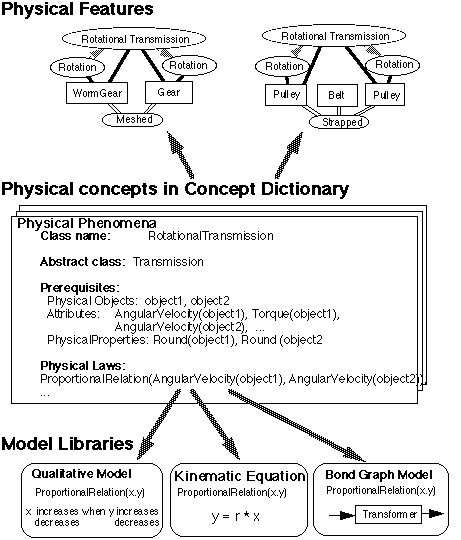KIEF (Knowledge Intensive Engineering Framework) is
a tool for supporting various engineering activity related to the whole
life cycle of artifacts; e.g. design, maintenance, and so on. In this framework,
various kind of engineering tools can be integrated by intensively storing
engineering knowledge and representing the relationship among them.
The KIEF has two major roles. It works as a knowledge base, and it manages various computational engineering tools by using pluggable metamodel mechanism that allows to plug in existing design object modelers. In this framework, all design object modelers in SYSFUND (SYStematization tool of FUNctional knowledge for Design) (e.g. Function Behavior State (FBS) modeler which is a CAD for conceptual design, qualitative physics based reasoning system) are already plugged in.
As a knowledge base, the KIEF accumulates concept dictionary which is a basic definition of concepts for knowledge bases represented in various engineering tools for management of the relationship among knowledge bases. In addition, since the KIEF includes all design object modelers in SYSFUND (e.g. Physical Reasoner based on Qualitative Process Theory, Function Behavior State (FBS) modeler, knowledge bases for these modelers accumulates functional knowledge about machines, knowledge about behavior and structure and so on.
As a CAD for conceptual design, the designer uses FBS
modeler for functional design. As a result, a function hierarchy and a
causal dependency network which depicts the basic mechanism, including
a topological structure, of the design object will be constructed. After
that, the KIEF system reasons out the possible physical phenomena
occurred on the designed object. From this description
of the designed object, the designer can make various design object model
(e.g., Physical reasoner base on Qualitative Process Theory, physical reasoner
based on mathematical model, and so on), and evaluate the designed object
for verifying its function.
Right side of Figure 1 depicts the three component architecture of the knowledge base system for KIEF. The middle component, called concept dictionary, contains physical concepts.
In the concept dictionary, physical concepts are categorized into the following six types.
Model fragments for building a model with various model representation are stored in the model library with the relationship to the concept stored in the concept dictionary.

Figure 2: Describing the Knowledge about Gear Transmission
in KIEF
Left side of Figure 1 depicts the pluggable metamodel mechanism which has a capability to use existing design object modelers (including commercial CAE tool such as solid modeler, FEM and so on). The pluggable metamodel system maintains the consistency by using metamodel that is a model which represents the relationships among concepts used in various design object models.
In the pluggable metamodel mechanism, a metamodel is constructed
by using physical features as building blocks. For plugging-in new design
object modelers, Knowledge about Modelers should be defined by using
the vocabulary in the concept dictionary. Model library is used as model
fragments while exporting the information in metamodel to the design object
modelers through Interface of Modelers.
Please consult manual for detail.